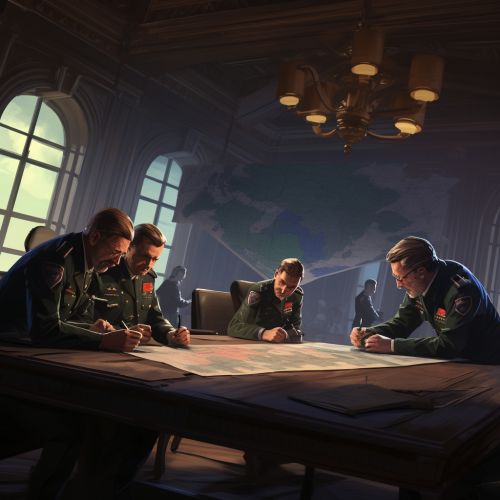High Command of the Army
Overview
The High Command of the Army (HCA) is a term often used to describe the highest echelons of military leadership within a nation's armed forces. This body typically consists of the most senior military officers who are responsible for strategic decision-making, operational planning, and overall military governance. The HCA is usually directly subordinate to the head of state or the minister of defense, and its members are often appointed by these political leaders.
Structure
The structure of the HCA can vary greatly from one country to another, depending on the specific military traditions, political context, and strategic needs of the nation. However, there are some common elements that are typically found in most HCAs. These include the Chief of Staff, who is often the highest-ranking military officer and the principal military advisor to the head of state and the minister of defense. The Chief of Staff is usually responsible for the overall strategic direction of the armed forces and for coordinating the activities of the different branches of the military.
In addition to the Chief of Staff, the HCA often includes the heads of the various branches of the armed forces, such as the Army, Navy, and Air Force. These officers are typically responsible for the operational readiness of their respective branches and for implementing the strategic directives issued by the Chief of Staff.
Other key members of the HCA can include the Inspector General of the Army, who is responsible for ensuring that the armed forces adhere to established standards of conduct and performance, and the Director of Military Intelligence, who is responsible for gathering and analyzing strategic information.


Roles and Responsibilities
The primary role of the HCA is to provide strategic leadership for the nation's armed forces. This involves developing and implementing military strategies, planning and overseeing military operations, and ensuring the readiness of the armed forces to respond to any threats to national security.
In addition to these strategic responsibilities, the HCA also has a number of administrative duties. These include managing the military budget, overseeing personnel issues such as promotions and retirements, and ensuring compliance with military regulations and standards of conduct.
The HCA also plays a key role in the formulation of defense policy. This involves advising the head of state and the minister of defense on matters of national security, providing input into the development of defense policy, and representing the military in discussions with other government departments and agencies.
Historical Perspective
The concept of a high command has been a feature of military organizations for centuries, although the specific form and function of the HCA have evolved over time. In the past, the HCA was often composed of the monarch and his closest military advisors. However, with the professionalization of the armed forces and the increasing complexity of military operations, the HCA has evolved into a more formal and structured body.
In the modern era, the HCA has become an essential component of the military command structure in most countries. The HCA is often seen as a key mechanism for ensuring the effective coordination of military activities, for maintaining civilian control over the military, and for integrating military considerations into the broader national security policy-making process.
